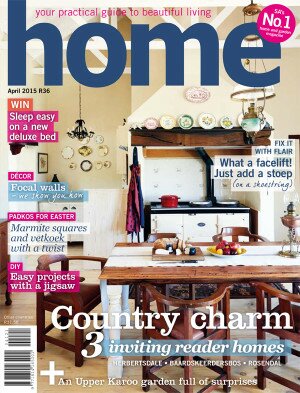-
Three Ways To Decorate Your Tiles!
Bring a touch of Morocco into your home by decorating your tiles
11 November 2014
WITH STENCILS
This method can be used on tiles that are not yet laid. Stencil your design onto the tiles with ceramic paint and bake them before you lay them. It’s quite a process, but is definitely worth the effort. We decorated a fireplace wall with our tiles – choose an adhesive and grout that can withstand heat well if you do the same.You Will Need
- tile design
- ceramic paint in the colour of your choice
- round sponge brush
- acetate
- craft knife, cutting mat and metal ruler
- spary glue
1 Copy your design in the desired size, place it on your cutting mat under the acetate and cut out your stencil. Apply spray glue to the back of the stencil and press firmly onto the tile.
TIP Cut the stencil the same size as the tile, to help you with the positioning, or mark the tile’s four corners on the stencil.
2 Press your sponge brush into the paint and blot it lightly so there is not too much paint on the brush. Paint the first coat on very lightly – be careful not to let the paint seep in under the stencil.
3 Apply more coats in this way, until the colour is even all over.
4 Carefully remove the stencil. Neaten untidy lines with a sosatie stick while the paint is still wet.
5 Stencil all the tiles in this way and leave the paint to dry. Follow the manufacturer’s instructions to bake the tiles – ours were baked for 40 minutes at 150°C. Seal afterwards with a suitable varnish.
GOOD IDEA You can also stencil tiles that have already been laid, but you will then need to apply a suitable sealant afterwards.
WITH A TRANSFER TECHNIQUE
You can use this method on a wall that is already tiled, like a bathroom wall. You can also use it to create a border decoration. We chose a pattern that is repeated over four tiles. Print out your design on water slides, cut out and stick onto the tiles. Seal afterwards with a suitable varnish to protect them, especially if there is a lot of moisture in the room.
NOTE This method is not suitable for a floor or the inside a shower.You Will Need
- picture in digital format
- water-slide transfer paper
- craft knife, cutting mat and metal ruler
- soft cloth or sponge
1 Use a laser printer and set it so that it can handle thick paper. Measure the tiles and print your image in the desired size on the plastic layer of the transfer paper. Try to fit as many pictures on one sheet as possible, to save paper. Cut them out neatly with your craft knife.
2 Rub the tiles clean and dry. Make a large enough container half full with lukewarm water, place one picture in the water and leave it to soak for a few minutes. Press the corners back if they curl up.
3 As soon as the glue between the two layers is soft, you can take the picture out of the water and slide the printed layer carefully with your hand onto the tile.
4 Move the picture so that it fits exactly on the tile – this is easy to do while it is wet.
5 Lightly rub the picture with a soft cloth or sponge to smooth and dry it.
6 Leave the tile until it is completely dry. Seal the picture afterwards with a suitable varnish.
WITH STICKERS
Cut your own pretty vinyl stickers to decorate your tiles. We cut the fine detail with the help of a Silhouette Cameo electronic cutting tool (available at selected craft shops). We used vinyl in just one colour, but you can also play with more colours. We created a focus point in this kitchen by decorating every second tile on the splashback with a sticker. The stickers will continue to look good for quite some time, but seal them with a suitable varnish if you want them to last longer.You Will Need
- cut-out vinyl stickers (you can use the simpler version of ours as a template)
- wide masking tape
- bone folder
- sticker template
1 If your stickers have also been cut with an electronic cutting tool, you must first remove the sections that you don’t want. Your stickers will then look like ours. For hand-cut stickers, follow the same steps – the stickers will already be cut through the backing paper.
2 Cover the front of the sticker with strips of masking tape.
3 Pull the sticker – which is stuck to the masking tape – away from the back layer.
4 Place the sticker with the masking tape on the tile and rub it to attach it to the tile. Use your bone folder or the back of the handle of your scissors for this.
5 Carefully pull the masking tape strips off one by one so that the sticker stays behind on the tile.
6 Do all the tiles in this way. Seal them afterwards with a suitable varnish, especially if the room is often moist.
Text and images: Ideas magazine






